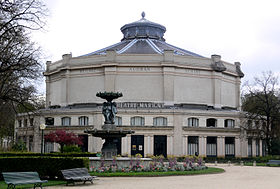- Théâtre Marigny
-
For the earlier theatre on this site, the Salle Lacaze, where Offenbach produced his first operettas, see Théâtre des Folies-Marigny.
Coordinates: 48°52′07″N 2°18′49″E / 48.868631°N 2.313669°E
Théâtre Marigny 
Théâtre Marigny from the gardensAddress located at the corner of
Avenue des Champs-Elysées
and Avenue Marigny, 8th. ParisCity Paris Architect Charles Garnier (panorama)
Édouard Niermans (theatre)Capacity 1024 (main hall)
311 (Popescu salon)Opened 1894 Previous names Panorama Marigny (1883-1894) www.theatremarigny.fr The Théâtre Marigny is a theatre in Paris, situated near the junction of the Champs-Élysées and the Avenue Marigny, in the 8th arrondissement. It was originally built to designs of the architect Charles Garnier for the display of a panorama, which opened in 1883. The panorama was converted to the Théâtre Marigny in 1894 by the architect Édouard Niermans and became a home to operetta and other musical theatre.
Contents
Panorama
An earlier theatre on the site, the Salle Lacaze, became known in 1855, as the home of Jacques Offenbach's Théâtre des Bouffes-Parisiens, where he first built his reputation as a theatre composer. In 1864 this became the Théâtre des Folies-Marigny, which was demolished in 1881, giving way to a panorama built by Charles Garnier. In 1885, dioramas on Paris through the ages by Theodor Josef Hubert Hoffbauer (1839-1922), and on Jerusalem on the day of the death of Christ, by Olivier Pichat, were displayed.
Théâtre Marigny
In 1894, Édouard Niermans converted the venue into a theatre-in-the-round for summer musical spectacles.[1] The hall was enlarged and modernised in 1925 by Volterra, and in that form opened with a revival of Monsieur Beaucaire (operetta) by André Messager. This success led the management to devote the venue mainly to operetta and other musical theatre until the 1930s. Thereafter the Marigny mounted boulevard shows, and revivals (such as La Créole by Offenbach in 1936).[2]
In 1946 the Théâtre Marigny welcomed a troupe from the Comédie-Française to form the Renaud-Barrault company, and in 1954, Barrault opened a smaller 'Petit Marigny'. The Grenier-Hussenot troupe followed and later the hall became a cinema. From 1965-1978 the direction passed to Elvira Popescu. In 1978 John Bodson succeeded her as director and the current director is Robert Hossein.
Musical theatre repertory
- J'te veux (12 February 1923)
- Monsieur Beaucaire (20 November 1925)
- Venise by Tiarko Richepin (25 June 1927)
- Le diable à Paris by Marcel Lattes (27 October 1927) (with Raimu, Edmée Favart)
- Coups de roulis by Messager (29 September 1928)
- Boulard et ses filles by Charles Cuvillier (8 November 1929)
- Madame Pompadour by Leo Fall (16 May 1930) (with René Hérent, Robert Burnier)
- Moineau by Louis Beydts (13 March 1931)
- La belle saison by Jean Delettre (29 June 1937) (with Lucienne Boyer)
- Mes amours by Oscar Strauss (2 May 1940)
References
- ^ Pinchon Jean-François, Édouard Niermans, architecte de la Café-Society, 1991, ISBN 978-2870094112
- ^ ’L'encyclopédie multimedia de la comédie musicale théâtrale en France (1918-1940) , accessed 15.07.09. (in French)
External links
Categories:- Theatres in Paris
- 8th arrondissement of Paris
Wikimedia Foundation. 2010.
